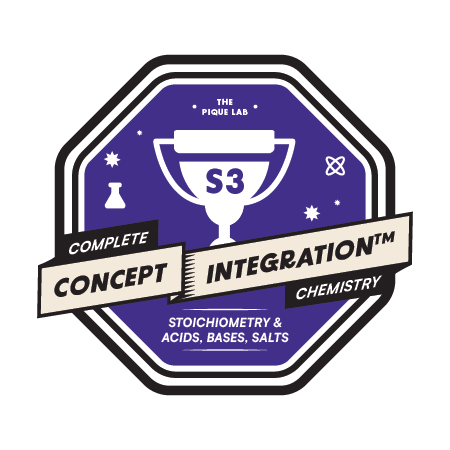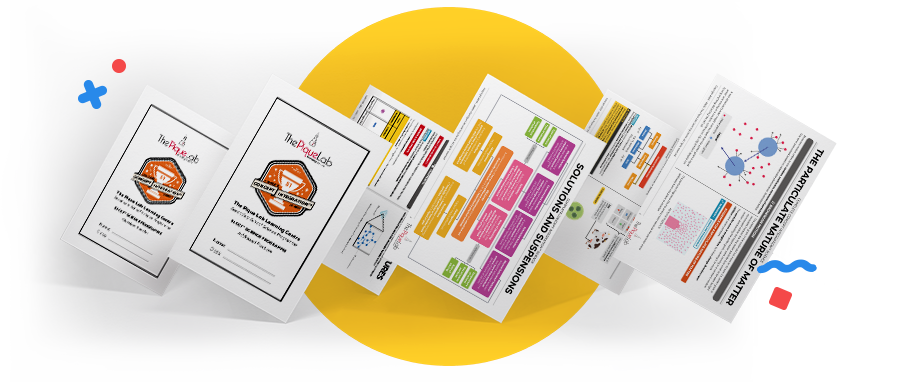
S$697
S3 Content Mastery Course
Become Great At Tackling Chemistry Questions
What Your Child Will Learn
During this 4-day content-packed S3 CCI™ Chemistry Course (Stoichiometry & Acids, Bases, Salts), we’ll work closely with your child to improve on his/her mastery of the subject matter:
🧱 Understand Key Chemistry Concepts In The Secondary 3 Syllabus
We’ll help to break down complex Chemistry concepts using coloured illustrations, comparison charts and worked examples.
Next, we’ll help your child relate these concepts with different scenarios so that he/she is better able to understand how these concepts work.
In order to help him/her retain information better, we will also introduce memory retention techniques, such as acronyms and abbreviations. As your child is expected to digest more content in upper secondary school, it will benefit him/her greatly to be able to recall key information easily.
We will also teach your child how to interpret graphs effectively and solve questions using Math.
🎯 Gain Exposure To Various Question Trends & Question Types
Our S3 CCI™ Chemistry Course (Stoichiometry & Acids, Bases, Salts) is all about understanding various examination question trends and question types & how to apply our tested and proven answering techniques to tackle these questions.
Knowing how questions may possibly be tested during examinations helps your child understand what to study and how to study. This also means that your child will be better equipped to tackle similar questions during his/her examinations and hence will be able to process these questions a lot faster than his/her peers.
If your child diligently reviews and applies what we’ve taught, he/she will definitely make progress in their abilities to tackle Chemistry questions.
🚀 Proven ‘Copy and Paste’ Answering Structures, Keywords & Key Phrases
Your child will NOT leave this workshop empty-handed.
Not only will our Chemistry Specialists take your child through the step-by-step process of tackling Chemistry questions, we’ll also provide your child with beautifully-illustrated notes and worksheets that are designed to help students learn Chemistry easier, better and faster.
These valuable resources will help to shorten the learning curve tremendously. You and your child can expect to save lots of valuable time and frustration trying to figure out what examination setters are looking out for.
💣 Avoid ‘Concept Traps’ That Cause Most Students To Lose Marks Unnecessarily
It is important to have an understanding of the common conceptual pitfalls so that your child can learn to avoid them. We also included little ‘warning notes’ to remind students of potential misconceptions in their syllabus.
Do not underestimate these tips as they will help your child improve the odds of scoring an A for his/her Chemistry examination!

S3 CCI™ Chemistry Course (Stoichiometry & Acids, Bases, Salts)
- Level Eligibility: Secondary 3 (O-Level (Express)/ IP/ IB/ IGCSE)
- Sessions: 4
- Total Duration: 12 hours (4 x 3hrs)
- Tuition Fee: S$697
- Learning Arrangement:
- Digital Classes
- Onsite Classes* (subject to changes to National Safe Management Measures)
Topic Coverage
- Session 1: Acids, Bases & Salts (Part 1)
- Session 2: Acids, Bases & Salts (Part 2)
- Session 3: Stoichiometry & Mole Concept
- Session 4: Qualitative Analysis
About Your Child’s Instructors
Your child will be taught by one of these instructors from our Chemistry Specialist team.

Here’s What Your Child Will Receive
When your child enrolls today, he/she can look forward to get access to:
- Beautifully-Illustrated Chemistry Notes
- 3 Core Topics Delivered Across 12 Hours of Lesson Time
- 149 Questions Adapted From Past Year Examination Papers
- 94 Additional Practice Questions
Course Details
Session 1
🧪 Topic: Acids, Bases & Salts (Part 1)
- Describe the meanings of the terms acid and alkali in terms of the ions they produce in aqueous solution and their effects on Universal Indicator.
- Describe neutrality and relative acidity and alkalinity, in terms of
- relative hydrogen and hydroxide ion concentrations,
- colour in Universal Indicator, and
- the pH scale
- Describe qualitatively the difference between strong and weak acids in terms of the extent of ionisation.
- Describe the characteristic properties of acids as in reactions with metals, bases and carbonates to form salts.
- Describe the reaction between hydrogen ions and hydroxide ions to produce water as neutralisation.
- Describe the importance of controlling the pH in soils and how excess acidity can be treated using calcium hydroxide.
- Describe the characteristic properties of bases in reactions with acids and with ammonium salts.
- Classify oxides as acidic, basic, amphoteric or neutral based on metallic/non-metallic character.
Session 2
⚗️ Topic: Acids, Bases & Salts (Part 2)
- Describe the techniques used in the preparation, separation and purification of salts (methods for preparation should include precipitation and titration together with reactions of acids with metals, insoluble bases and insoluble carbonates).
- Describe the general rules of solubility for common salts to include nitrates, chlorides (including those of silver and lead), sulfates (including those of barium, calcium and lead), carbonates, hydroxides, salts of Group 1 cations and ammonium salts.
- Suggest a method of preparing a given salt from suitable starting materials, given appropriate information.
Session 3
⚖️ Topic: Stoichiometry & Mole Concept
- Define relative atomic mass, Ar.
- Define relative molecular mass, Mr, and calculate relative molecular mass (and relative formula mass) as the sum of relative atomic masses.
- Define the term mole in terms of the Avogadro’s constant.
- Calculate the percentage mass of an element in a compound when given appropriate information.
- Calculate empirical and molecular formulae from relevant data.
- Calculate stoichiometric reacting masses and volumes of gases (one mole of gas occupies 24 dm3 at room temperature and pressure); calculations involving the idea of limiting reactants may be set.
- Apply the concept of solution concentration (in mol/dm3 or g/dm3) to process the results of volumetric experiments (e.g. titration) and to solve simple problems.
- Calculate % yield and % purity.
Session 4
🔎 Topic: Qualitative Analysis
- Describe the use of aqueous sodium hydroxide and/or aqueous ammonia to identify the following aqueous cations through the formation of precipitates (if any) and their subsequent solubility: aluminium, ammonium (together with evolution of ammonia gas upon warming), calcium, copper(II), iron(II), iron(III) and zinc.
- Describe tests to identify the following anions: carbonate (by the addition of dilute acid and subsequent use of limewater); chloride (by reaction of an aqueous solution with nitric acid and aqueous silver nitrate); iodide (by reaction of an aqueous solution with nitric acid and aqueous silver nitrate); nitrate (by reduction with aluminium in aqueous sodium hydroxide to ammonia and subsequent use of damp red litmus paper) and sulfate (by reaction of an aqueous solution with nitric acid and aqueous barium nitrate).
- Describe tests to identify the following gases: ammonia (using damp red litmus paper); carbon dioxide (using limewater); chlorine (using damp litmus paper); hydrogen (using a burning splint); oxygen (using a glowing splint) and sulfur dioxide (using acidified potassium manganate(VII)).
Who Should Attend This Course?

Any student who wants to score A1 for Chemistry, but is reluctant to revise using the traditional DRILLING method. Your child is the kind of student who wants to outperform his/ her peers & study the SMART way, like many other high performing students.


Don’t Just Take Our Word For It.
Hear What Parents & Students Have To Say About Their Experience With Us.
Materials Are Very Useful!
“The S3 CCI Chemistry Course and materials are very useful!
Easy To Understand!
“Mr Ryan is friendly and tried to explain the concepts during the S3 CCI Chemistry Course in detail, which makes the lesson easy to understand.
More Confident Of The Subject Now!
“Mr Ryan Seow is a good teacher, he is engaging and explained the concept during the S3 CCI Chemistry Course clearly and well. Lois has a much better understanding and is more confident of the subject now.
If You’re Still On The Fence, Hear Us Out.
In case you’re wondering…
This is NOT one of those enrichment programs where students gain loads of theories and do nothing with them afterwards! As your child will get to apply whatever they’ve learned directly on school examination questions during the course … by the time your child has completed the course, he/ she will be trained on how to tackle his/ her school homework & school examination papers accurately & efficiently. Not a month later… or even a week later, but immediately! During the S3 CCI™ Chemistry (Stoichiometry & Acids, Bases, Salts) course, we’ll be revealing some massively potent studying strategies used by our top-performing students. These strategies have helped them save hours studying every day and yet allow them to score A1s during their school examinations time & time again!
So… if you are looking for:
1) A highly robust methodology to sharpen your child’s Chemistry answering techniques, especially in their open-ended section (… such that he/she no longer loses marks unnecessarily due to missing links, key words or key phrases) 2) An engaging teacher with a strong proven track record (… trust me: teachers make or break the learning experience for students. Set them up with the right teacher & they’ll enjoy the learning process for life) 3) A comprehensive set of visually-appealing revision materials that high-performing students use to excel in their examinations (… you’d want your child to get his/her hands on these materials & start revising now. The best part: Your child doesn’t have to spend countless of hours trying to study, because we’ve distilled the most important parts to take note!) … then this course may just be perfect for your child.

Now, let’s be real. Is this going to be easy?
There is ALWAYS going to be a bit of discomfort, uncertainty and plenty of hard work when your child is trying to learn and apply our answering structures to tackle examination questions. That is normal & many of our students go through the same process all the time. Once your child pushes past that discomfort, that’s when you will notice real growth in his/her learning. It will not be a walk in the park, but we have plenty of materials & close guidance to help your child improve his/her answering techniques! We’ll see your child at the workshop!
Frequently Asked Questions
How is the S3 CCI™ Chemistry Course (Stoichiometry & Acids, Bases, Salts) different from other tuition programs out there?
Will there be breaks in between classes?
What topics are covered?
- Session 1: Acids, Bases & Salts (Part 1)
- Session 2: Acids, Bases & Salts (Part 2)
- Session 3: Stoichiometry & Mole Concept
- Session 4: Qualitative Analysis
Will there be homework provided during the workshop?
There’ll not be any homework given during the workshop. The S3 CCI™ Chemistry Course is a highly intensive workshop. Both concepts and answering techniques will be taught in class and we’ll teach your child how to apply these techniques on secondary school examination questions. We will give your child a question booklet containing a curated list of open-ended questions adapted from secondary school examination papers. These questions have been adapted from different schools & sorted based on their topics. A portion of the questions will be attempted & reviewed in class. The remaining questions can be brought home for their own practice. We’ll also send you an answer booklet for the questions in the S3 CCI™ Chemistry Course.
My child is in the IP/ IB/ IGCSE academic track. Is your programme suitable?
Our S3 CCI™ Chemistry Course (Stoichiometry & Acids, Bases, Salts) is designed based on the O-Level (Express) track.
Based on research, it appears that there’re only minor differences in terms of content coverage between the O-Level (Express) track and the IP/IB/IGCSE track at a lower secondary level.
As such, it will be suitable for your child to participate if he/she is interested.
Who is the instructor for the class?
What is the maximum class size?
Our S3 CCI™ Chemistry Course is typically fully booked. You can expect the class to have 14 to 16 students.
What kind of materials would my child be getting?
These questions have been carefully adapted different schools & sorted based on their topics. As such, your child would have the opportunity to apply the thought processes and answering techniques learnt on these questions immediately.
S3 Complete Concept Integration™ Chemistry Course Details
Suitable For Students In O-Level (Express)/ IP*/ IB*/ IGCSE* Track (*See FAQ)

Course Registration Form
Please fill in the following form accurately.
Note: You’ll be redirected to a confirmation page after the above registration has been successfully processed.

